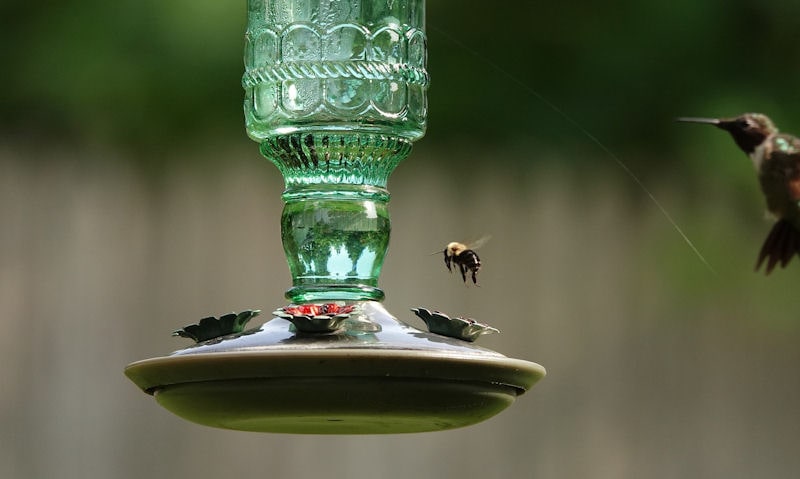How to get rid of bees on hummingbird feeder
While bees are beneficial pollinators, this time at the feeders they can feel like a pest, so let's see how we can get rid of bees without causing harm.
How to get rid of bees on hummingbird feeders requires bee guards, or to upgrade to a feeder with bee guards included. Since bees are attracted to the yellow flower imitated feeding wells, it could be as effective to buy a more bland feeder. More so, maintain a clean feeder, free of sugar water on the exterior.
Bees can continue to be a nuisance to feeding hummingbirds so much, it could result in them going elsewhere, or worst still, hummingbirds receiving an awful bee sting.
Rid bees of the hummingbird feeders in the less destructive way possible, by applying bee guards if made compatible - or buy a new feeder that comes with bee guards included.
What type of hummingbird feeders I do like is the antique metal style feeders, lacking of color or following the usual hummingbird feeder design.
Bonus of this far more bland but still beautiful feeder is it can be less attractive to bees, while hummingbirds can still understand what it is.
To stop bees swarming around the hummingbird feeder, you need to cut them off from the sweet sugary treat within. Unfortunately, that sugar water can end up on the outside of feeders due to use or leakage.
If the sugar water is resting in drops on the outside, it would be easy pickings for bees.
I would then advice you to not only go about cleaning your hummingbirds properly twice a week or more - but be sure to throw water over the hummingbird feeder at least once a day to prevent any sugar residue build up in and around the feeding wells.
Top rated hummingbird feeders often come with a bee guard, so check out my list for those only featured with guard inserts.
Upgrade to Bee Guard feeder
Obvious as it may seem, in the end an upgrade to a new and improved hummingbird feeder might just be what is needed.
In fact, there may not be any other way to rid bees at the hummingbird feeders, other than replacing it with a feeder fixed with bee guards inserted in the feeding wells.
I don't believe its possible to buy a set of bee guards to attach to any current or later purchased feeders - so you will then need to buy a hummingbird feeder with bee guards included, rather than upgrading later with difficulty.
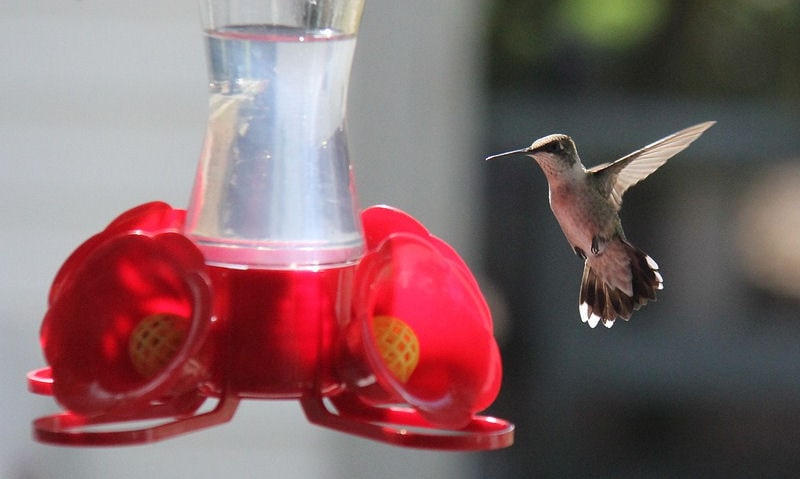
For example, you can buy bee guards from Perky Pets as an accessory to their range, but its not universal nor compatible with certain feeders in their collection.
How a bee guard works is to pop it into the open sugar-water feeding wells to allow hummingbirds to feed through minuscule gaps, while preventing bees accessing the feed ports, as bees are too plump to pass through.
While bees are unable to penetrate the guard, hummingbirds can carry on feeding as normal with their long, narrow beaks that can pass through open gaps.
Hummingbird feeders benefit our backyard hummingbirds hugely, with no real downside other than pests such as bees that frequent feeders alongside hummingbirds.
Downgrade to less color
Bees are attracted to the bright, colorful features of a standard hummingbird feeder, as much as hummingbirds are themselves.
Unlike hummingbirds though bees can be distracted of bright colors by simply downgrading to a less bright, more natural tone color feeder.
And not to worry, as most hummingbirds can continue to find and feed off their regular feeder - providing where you put the hummingbird feeder remains in the same location.
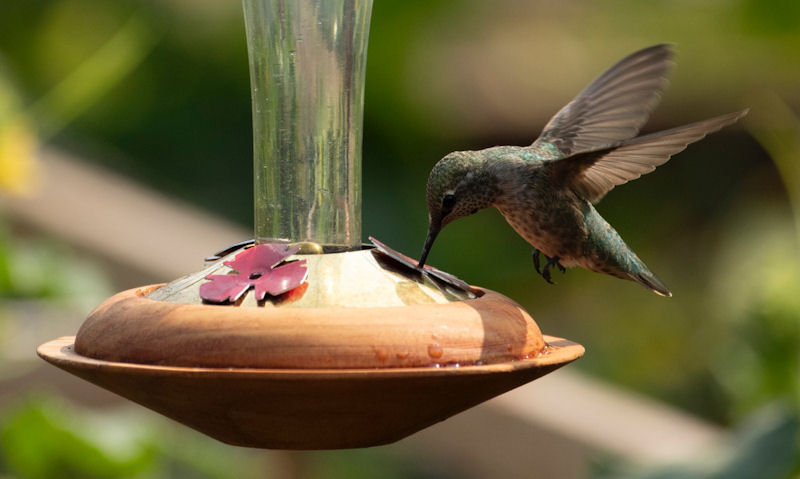
I would therefore recommend you take your brightly colored red hummingbird feeder down, and replace with the tone of a vintage style metal feeder, for example.
Benefit to that is the bright colors that draw bees in tend to not be present on vintage or antique style feeders.
More so, the often yellow color of the feeding port wells are less obvious or blend in with the theme of the feeders, thus it becomes less obvious to bees but still hummingbirds know what is it.
Maintain a tidy feeder
I can't say it enough, while its important to give the hummingbird feeders a proper clean twice weekly, a little maintenance in-between the thorough cleaning schedule is a requirement.
Its certainly not said enough that's for sure, but over the course of a day the feeder can get used by many birds, resulting in water spillages or leaking.
That brings the secured sugar-water out into the open, inviting pollinating bees to feed in and around the feeding wells - all while making a nuisance of themselves among the hummingbirds.
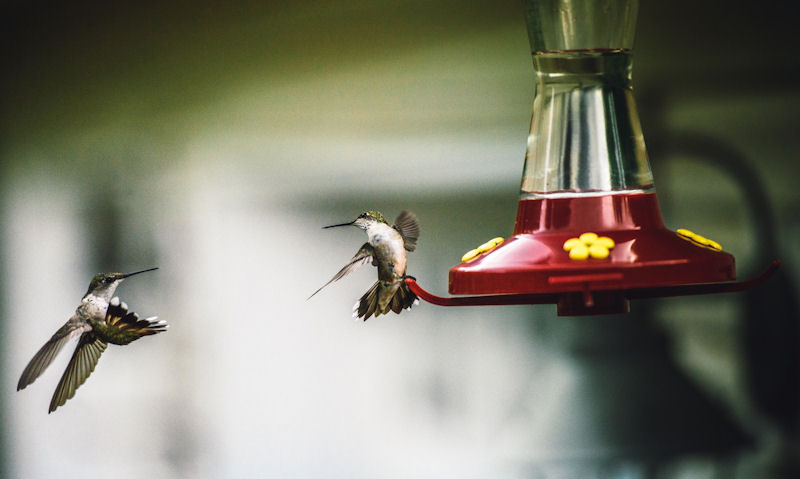
Its up to you then to maintain a tidy hummingbird feeder on the outside, but primarily in and around the feeding port wells.
In an effort to keep bees well away, its vital to also wash off leaking sugar water on the ground below the feeder, as often as you possibly can.
Maintain a tidy feeder on the outside as bees can simply feed on access sweet sugar-water as seen on the exterior.
Regularly pour over water
Rather than clean the hummingbird feeder more than you need too, wait until the hummingbirds have vanished for the day before pouring or splashing room temperature water over the hanging hummingbird feeders.
Better still, to use the force of a garden hose or pressure washer would only take a minute, and be far less hassle.
Maintaining a tidy hummingbird feeder, free of spillages on the outside with sugar-water can contribute hugely in an effort to keep bees, as well has other pests out of the the way.
To go gently on feeders you wouldn't need to bring it down off its bracket or mount, but to use a little more force you'd need to bring the feeders down as to prevent risk of them dropping while being cleaned with force.
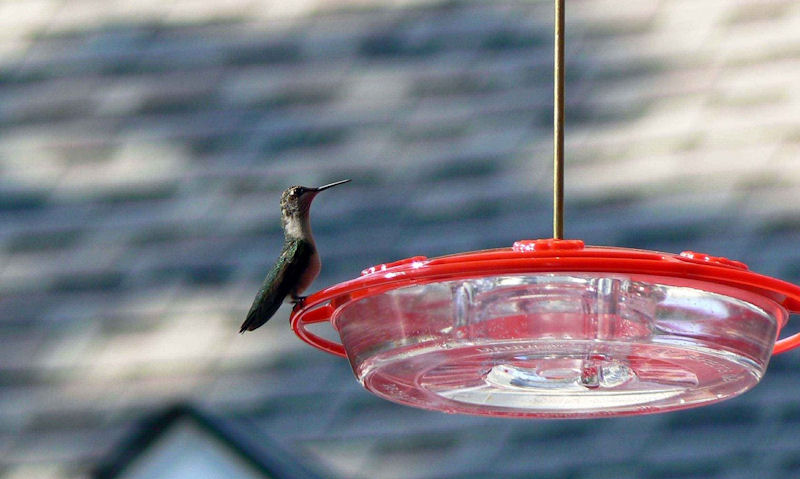
Its only regular tap water you need at this stage just to wash off the sugary water before it has enough time to stick to the outer feeder.
Once a day should do it but to make it twice a day in busier times would be ideal.
To pour water over feeders everyday is not a substitute for a cleaning hummingbird feeders, that is reserved for twice a week with soap dish or a part vinegar solution. This way its just to prevent the sugar mix resting on top of the feeder exterior.
Stabilize unsteady feeders
Of course to maintain a tidy hummingbird feeder to prevent bees accessing the sugar water on the outside, you must stabilize the feeder before you do anything else.
While this primarily applies to hanging hummingbird feeders only, a mounted feeder with a strong fix would see no movement at all.
With your hanging hummingbird feeder then, you'd need to prevent it from swinging in the wind, or at least prevent it moving in a little gust.
First thing to so is recognize if there's a better place in your backyard that is less prone to wind - like a wind tunnel in an alley way or near a breezy catchment area.
To fix an unstable hummingbird feeder can be corrected using a length of string or rope, as its tied to the hummingbird feeder perch, while the other end would be tied to a post or similar object to create a stable feeder.
In the process, you may need to go one better by fixing two or three rope lengths as the feeder could still swing in most circumstances.
Knot ends must be on a stable object like a post or even impaled into the ground if using tend pegs - as a strong gust of wind can bring it all tumbling down to the ground.
Remove feeders temporarily
Difficult as it is to get rid of bees on a hummingbird feeder, its fair to say all options outlined thus far may still not be enough.
What you would be left with then is simply removing the feeders out of the yard.
It may not be that easy because while its quite an effective method of ridding bees around the feeder, for if it disappears for a while - similarly hummingbirds would have to go without too, thus requiring them to find new feeding grounds.
If bees become too much of a nuisance, then the idea of removing hummingbird feeders for a day or two is a must.
This would be no good unless you clean up the mess around the hummingbird feeder of all traces of the sweet sugar water, often dripped down directly below it.
Hummingbirds only stay for a few short months in spring through summertime for many of us, so you don't want to risk wasting too many days of deterring bees with the idea of removing feeders.
Never use this method is times of drought or harsh summer weather, as hummingbirds need a constant supply of sugar water, so could suffer if feeders are brought into the house randomly one day.
Conclusion
How you get rid of bees on a hummingbird feeder would require you to mount bee guards on the feeding port wells.
Not all feeders are compatible with such a move, so therefore it could be you'd need to upgrade to a hummingbird feeder with bee guards, in which are very effective.
Bees are attracted to the bright colors of hummingbird feeders, and so to the imitation yellow nectar flowers that act as feeding ports.
I would then recommend you to buy an hummingbird feeder that uses less color, but with a focus of unrecognizable feeding port well holes - to blend in with the entire body of the feeder so bees are not drawn to the holes where the nectar rests.
Bees can access the sugar water mix inside a hummingbird feeder when it simply drips or leaks on the outside. Its vital then to maintain a clean hummingbird feeder at all times, with a focus on the outside.
While a hummingbird feeder must be clean twice a week, its important to intersperse this with a wash of room temporary water poured or splashed over the feeder with a bucket, hose pipe or pressure washer.
No soap or chemicals are needed, just tap water to wash away the build up of sugar on the outside.
Most times the sugar water ends up on the outside due to use, but it could be as the feeder rocks in wind, the port holes leak more - so be sure to stable the feeder with use of two or three lengths of ropes tie connections.
